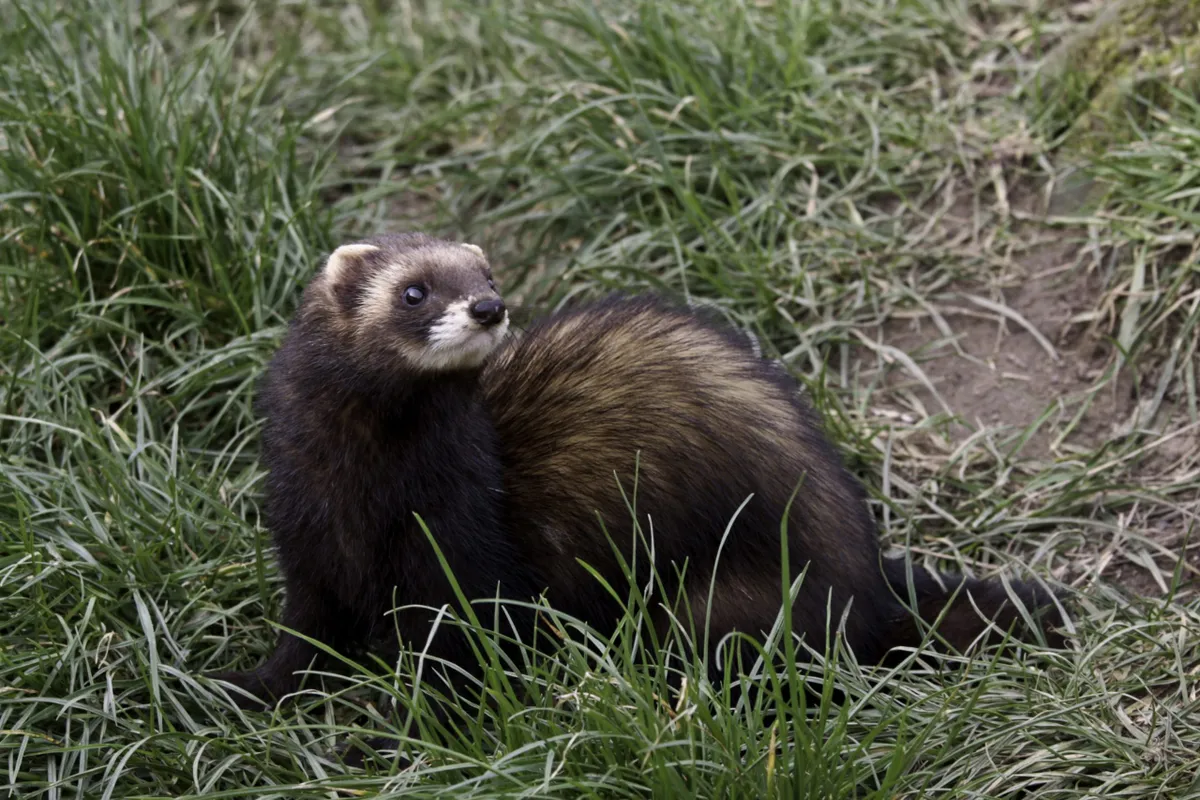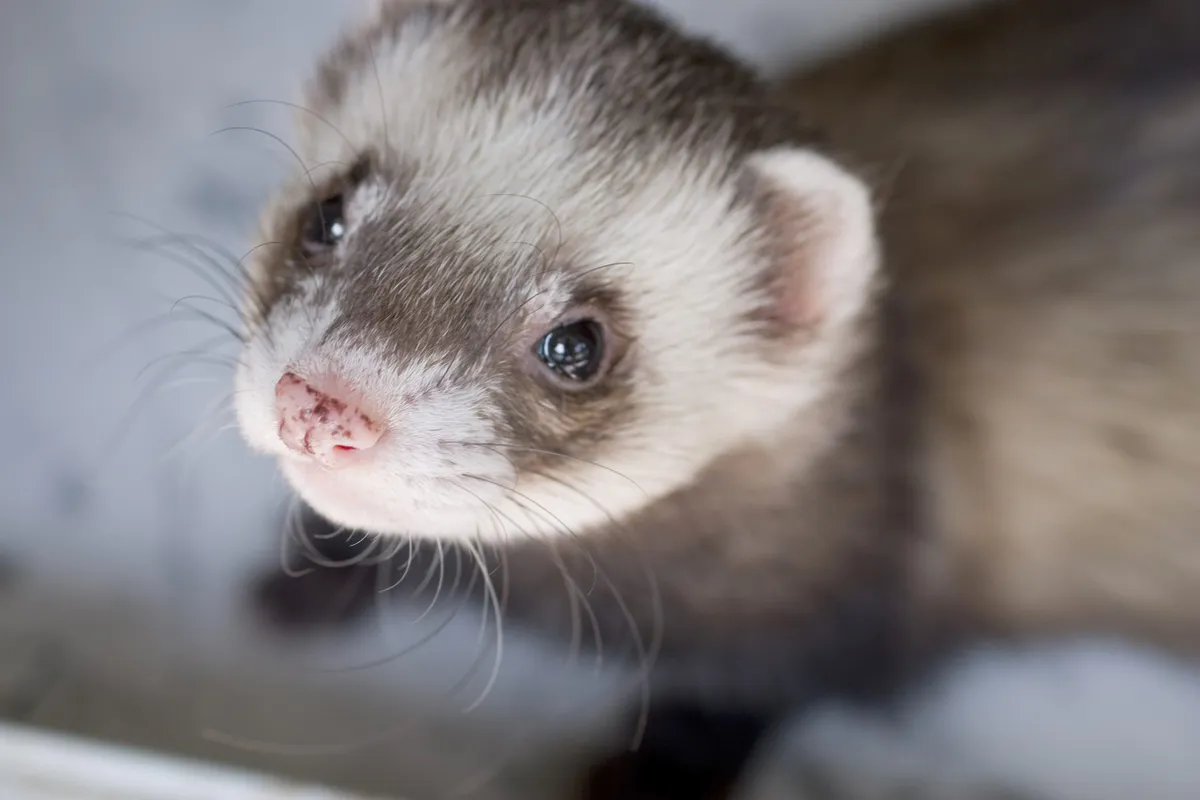The European polecat is one of Britain’s lesser known carnivores. Find out more in this expert guide from Vincent Wildlife Trust.
What is the scientific name of a European polecat?
The scientific name of the European polecat, usually just referred to as polecat, is Mustela putorius.
What are polecats related to?
The polecat is part of Mustela genus, also known as the weasel family, which is part of the Mustelidae family. In Britain, there are a number of species in this family, such the stoat, weasel, pine marten, otter and badger. Other mustelid species around the world include the honey badger, American mink, tayra, wolverine and fisher.
Please note that external videos may contain ads:
Learn more about mustelids:
How to identify polecats
The polecat has a long slim body with short legs and is about the size of a ferret. It is generally dark in colour, but paler underfur gives the body a slightly lighter appearance.
This is especially noticeable in winter, when this pale underfur is longer and thicker. The polecat’s most distinguishable feature is its dark facial ‘mask’, with white fur above the eyes and around the mouth.

What is the geographical range of the polecat?
Polecats have a wide distribution across Europe, from Britain and Portugal in the west to the Ural Mountains of Russia in the east. They have never been found in Ireland.
What is the polecat’s preferred habitat?
Polecats are fairly generalist and not dependent on any one habitat type. In some studies, they’ve shown a preference for riparian vegetation, wetlands, grasslands, pastures, agricultural land and montane pine forests. In Britain, they are more numerous in lowland landscapes. When moving around, polecats use features like hedgerows and woodland edge.
When choosing den sites, polecats prefer to use existing structures such as rabbit burrows, hay stacks and log piles.
What do polecats eat?
In Britain, most of the polecat’s diet comprises rabbits. They also eat rats and other small rodents, amphibians and birds.
Why did the polecat decline in Britain?
Like many of our other carnivores, the polecat declined in Britain as a result of historical predator control and persecution associated with gamekeeping and sporting estates.
How are polecats doing in Britain?
The polecat population has been recovering and re-colonising parts of its former range in Britain since the mid-20th century. They are now widespread in Wales, central and southern England and are also established in parts of northern England. Although present in a couple of isolated areas of Scotland, they are largely absent from the country.
Polecats are now more widespread in Britain than at any time in the last 100 years. By contrast, elsewhere in Europe, polecats are declining in many countries across their range. The causes of this decline are not well-understood.
What is being done to help the polecat in Britain?
Polecats have been recovering largely under their own steam, spurred on by a reduction in persecution pressure. The polecat is now partially legally protected and is listed on Schedule 6 of the Wildlife and Countryside Act 1981, which prohibits certain methods of killing or taking of the animal.
There have been some translocations and releases of polecats to Cumbria, parts of Scotland and south-east England, with mixed success.
Are there any threats to polecats?
A major cause of mortality in polecats is vehicle collisions on roads, particularly during the mating season (February-March) and juvenile dispersal (September-October).
Polecats are also vulnerable to secondary rodenticide poisoning. They become exposed to second-generation anticoagulant poison through eating rats and other small mammals which have ingested poison. A 2018 study found that 79% of polecats had been exposed to rodenticides; a 1.7-fold increase since the 1990s. It’s not yet known whether this will affect the polecat’s ongoing recovery.
Polecats may also die or become injured in traps set for other species, such as grey squirrels, stoats and weasels.
How can I survey for polecats?
Polecats don’t leave many distinctive field signs and their scats (droppings) are hard to find. Polecats can be recorded on camera traps and may be attracted by a variety of bait.
How easy is it to see a polecat in the wild?
Polecats are elusive and therefore difficult to see in the wild. Most sightings involve seeing one run across the road at night. Polecats will sometimes visit gardens and may be attracted to food put out for other mammals such as foxes or hedgehogs. There are not any hides or places established for ‘polecat watching’ so it mostly relies on luck!
What is the difference between a polecat and ferret?
The polecat is the ancestor of the domestic ferret. Polecats and ferrets will breed, creating polecat-ferret hybrids.
Breeders have also ‘back-crossed’ domestic ferrets with wild polecats to produce a variety of colours. Some ‘ferrets’ can be distinguished from true polecats with certainty only by genetic analysis.

As a result, a confusing mix of ferrety polecats lives alongside true polecats in the British countryside, reducing the overall purity of the wild population. The occurrence of ferret genes among our polecat population may not, though, represent a threat, and may even be advantageous in increasing genetic diversity.
Polecats suffered a catastrophic decline during the 19th century, after which the population was almost entirely restricted to a stronghold in mid-Wales.
Hybrids occur mostly at the edge of the expanding polecat range, and true polecats appear to outcompete hybrids in the long term.
There is also no clear evidence of a ‘genetic bottleneck’, so the long history of cross-breeding with ferrets may have obviated the expected reduction in genetic diversity.
Polecats and ferrets can be distinguished by genetic analysis and also by their pelage (fur) characteristics. A full guide to distinguishing the two can be found on the VWT website.
Behaviourally, polecats and ferrets are quite different. Ferrets, as a domestic animal, tend to be more tame and docile and generally lack the skills needed to survive in the wild.
Test your mustelid ID skills with the BBC Wildlife quiz:
The Vincent Wildlife Trust is a wildlife charity focusing on mammal research and conservation in Britain and Ireland. Increasingly, the Trust also works in mainland Europe.
Main image: Polecat. © Anne Newton
